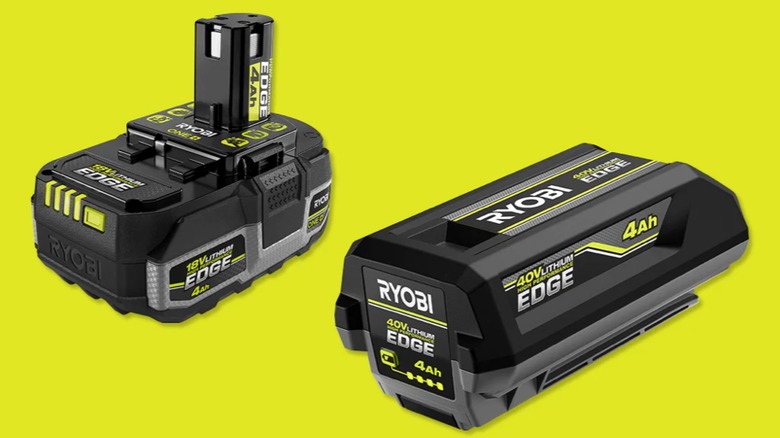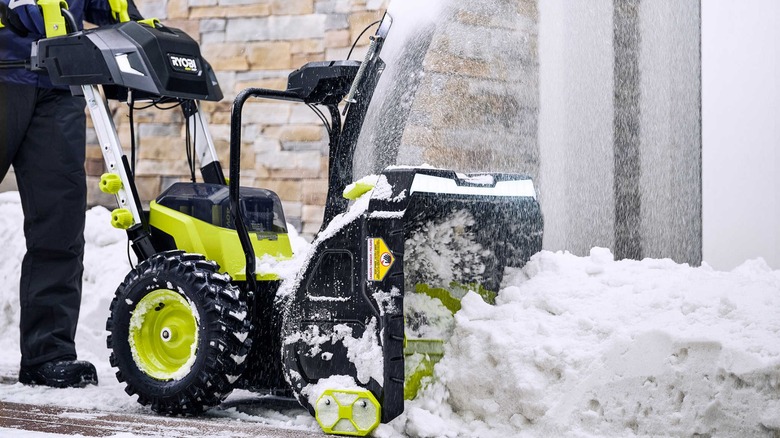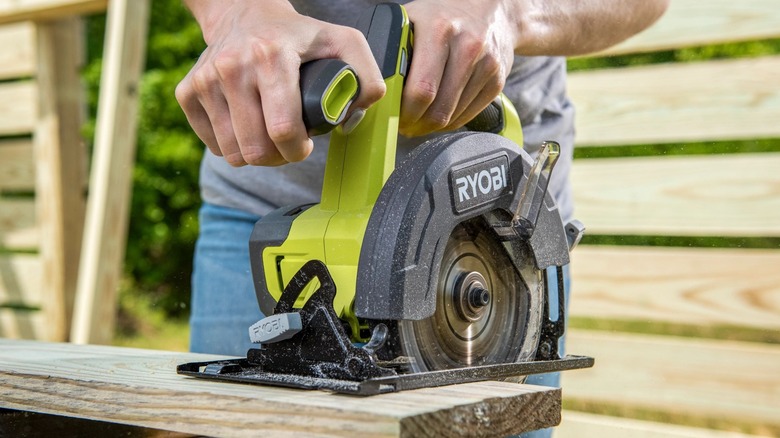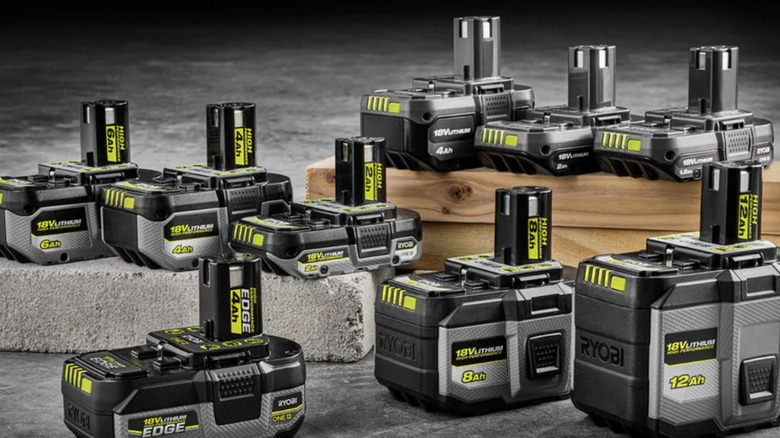If Your Ryobi Battery Doesn't Last Long Enough, This Could Be Why
We may receive a commission on purchases made from links.
Whether you're performing DIY repairs at home or you're a trained professional, using cordless tools offers a level of convenience that makes it hard to go back to ones tethered to a power outlet. Not only are they more portable, but it's a lot easier to maneuver and operate cordless tools in awkward or tighter spaces. One drawback, however, is that these tools are completely dependent on the quality of the batteries that power them — if they're draining quickly, you're not going to get a lot of work done.
Even tools from brands with strong reputations for their quality, like Ryobi, won't be of much use if you're having battery issues. There are a few common problems that can happen to Ryobi batteries, including draining too quickly. If you find that your Ryobi battery doesn't last long enough, there are a few possible reasons why. Once you identify the issue, you can take the necessary steps to remedy the problem and get your power tools — including the newest Ryobi tools available — up and running again.
One cause you may be able to quickly identify is extreme temperatures. Ryobi recommends that you charge the battery somewhere where the temperature is below 80 degrees Fahrenheit, and says that exposing the batteries to below-freezing weather can damage the unit. The manufacturer also suggests that you avoid exposing Ryobi batteries to rain or direct sunlight. If you haven't been adhering to these guidelines and find that your batteries don't last as long as they used to, this could be why. You want to avoid the elements not just while using Ryobi batteries, but also when storing them — they should be kept in dry areas that aren't subject to extreme temperatures.
How you store and maintain your Ryobi batteries is important
In addition to avoiding humid conditions or extreme temperatures when storing your Ryobi batteries, there are other ways you can protect them. Ryobi recommends that if you don't expect to use your tools for a while, you should make sure your batteries are partially charged before you put them away. If you've drained the battery and didn't recharge it afterward, storing the discharged battery for an extended time could affect its overall capacity the next time you charge and use it. Even the best Ryobi 18V tools won't do you much good if you're using them with compromised batteries.
Maintenance is just as important as storage when it comes to Ryobi batteries. There's a decent chance you're using Ryobi products in messy conditions that can produce sawdust, dirt, and other debris. Before you store away your (partially charged) batteries, take a few moments to brush the metal contact points where the battery meets the tool. Even small debris obstructing these contact points can affect the energy flowing from the power source to the tool, so you should take care to keep these contacts clean on both the battery and the tool. Use a dry cloth — it's best not to get them wet.
Just as how you maintain and store your Ryobi batteries can affect how long they last, how you use them in the short term can influence their long-term quality. Only use the appropriate power settings for a given application and lower the speed of the tool when you can, as running a Ryobi power tool at full strength for extended periods may drain the battery more quickly.
The battery may be fine, but not the right one for the job
Not all Ryobi tools are the same — even those that exist in the same power system and are compatible with the same batteries, such as Ryobi's 18V One+ line. For example, the Ryobi 18V One+ Cordless Circular Saw and Ryobi 18V One+ Compact Drill/Driver can both use the same 18V batteries, but the saw requires a lot more power to run and will drain the capacity a lot faster.
The solution to this particular problem is to pair more powerful tools with higher-capacity batteries. The brand sells 18V batteries in various sizes, including 1.5Ah, 2Ah, 4Ah, 6Ah, 8Ah, and even a massive Ryobi 18V 12Ah battery. You might be thinking to yourself that it would be better to just have the larger battery in all situations, as you won't need to charge it as frequently. However, bigger power units like the 12Ah battery have downsides because of its size. It could be uncomfortable to use a tool with the additional weight of the battery for long periods of time, especially if you're working overhead.
There are also some Ryobi tools where — even though the battery contacts are compatible — the 12Ah unit is simply too big to fit with the design of the tool. The best way to ensure that you're using the right battery for your Ryobi tool is to check which options the manufacturer recommends on the box or product page of that particular device.
Once you know why your battery is compromised, you can take steps to rectify the situation
Now that we've looked at the likely reason why your batteries might not last, you can now take steps to prevent further damage. For instance, if you've been keeping your batteries in an unheated garage and live in a cold climate, find somewhere warmer to store them. If you like to run your tools at full power the entire time, figure out when you can get away with operating them at lower settings. If the problem is debris on the battery contacts, your battery may be as good as new once you carefully clean the unit.
Also, keep track of how long you've owned a particular Ryobi battery — if it's over three years old, and you notice it's dying quickly, it may just be old age. Sometimes, even after trying all the troubleshooting tips for a Ryobi battery, there's nothing you can do — the battery, even a new one, just may be defective. You might be able to send it in for repairs, though it could be easier to just buy a new one. Depending on how long Ryobi's warranty is for your particular battery, you may be able to get it replaced for free.
If you're not already doing so, you should monitor your batteries as they charge every once in a while. Certain Ryobi battery chargers have multicolored LED lights that can convey information such as overheating or defective units. After all, it would be better to find out your battery isn't 100% before you start using it, rather than in the middle of a job.



